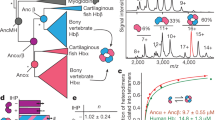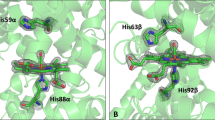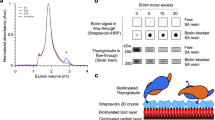Abstract
HAEMOGLOBIN oligomers have been found in amphibians, reptiles, mice and men1,2. These haemoglobins have been shown to dimerize by forming intermolecular disulphide bridges, and belong to the characteristic vertebrate type having molecular weights of about 68,000 in the monomeric form2.
This is a preview of subscription content, access via your institution
Access options
Subscribe to this journal
Receive 51 print issues and online access
$199.00 per year
only $3.90 per issue
Buy this article
- Purchase on Springer Link
- Instant access to full article PDF
Prices may be subject to local taxes which are calculated during checkout
Similar content being viewed by others
References
Trader, C. D., and Frieden, E., J. Biol. Chem., 241, 357 (1966).
Bonaventura, J., and Riggs, A., Science, 158, 800 (1967).
Scheler, W., and Schneiderat, C. L., Acta Biol. Med. Germ., 3, 588 (1959).
Porath, J., in Pharmaceutical Chemistry, IUPAC, 233 (Butterworths, London, 1963).
Benoît, H., and Weill, G., Proc. Intern. Symp. Macromol. Chem. Prague. Coll. Czech. Chem. Commun. (spec. ed.), 22, 35 (Pergamon Press, London, 1957).
Wong, S. Y., J. Biol. Chem., 77, 409 (1928).
Brohult, S., J. Phys. Coll. Chem., 51, 206 (1947).
Author information
Authors and Affiliations
Rights and permissions
About this article
Cite this article
RUSSELL, J., OSBORN, J. New Tetramer of Tubifex Haemoglobin. Nature 220, 1125–1127 (1968). https://doi.org/10.1038/2201125a0
Received:
Issue Date:
DOI: https://doi.org/10.1038/2201125a0
This article is cited by
Comments
By submitting a comment you agree to abide by our Terms and Community Guidelines. If you find something abusive or that does not comply with our terms or guidelines please flag it as inappropriate.



